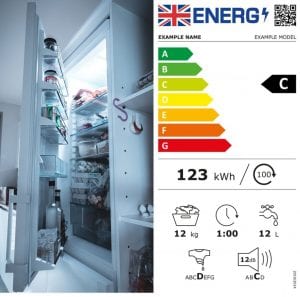If you haven’t purchased a new freezer in recent months, you may not know about the changing energy efficiency standards for white goods.
Richard Lupo, SHIFT’s Managing Director, recently purchased a new fridge. Ever the conscious environmentalist, his choice of a previously high-rated energy efficient product was now at a much lower energy efficiency rating. The new scale has seen originally A+++ classification products, now only rating B, C or worse with the introduction of a new energy efficiency scale.

What is an energy efficiency scale?
Energy efficiency ratings aid us in making informed decisions about the products we use, giving us insights into long-term running costs and the greenhouse gas emissions. Based on the amount of energy a device uses, the fewer units of energy (kWh), the better the rating.
The scale, first introduced 20 years ago in order to drive development and innovation, resulted in improvements to the energy efficiency of white goods. Originally A-F, the scale developed overtime with the introduction of more energy efficient appliances, causing the scale to adapt to A+, A++, and A+++. As more and more products are added into the mix, this advancement in technologies means that improvements to products could have seen more and more “+” introduced. To avoid confusion, the EU labels are now adjusted to a simpler A-G scale. Class A has been left empty to allow room for more energy efficient models.
This new change came into effect in March 2021 and is applied to fridges and freezers, dishwashers, washing machines, televisions, and lamps.
Domestic EPC ratings
Sadly, we haven’t seen the same thing happen for UK housing. Despite the EPC scale being around for well over 10 years, average homes are still around “EPC D”, new build is mostly “EPC B” and there are virtually no homes that would qualify for an “EPC A+” rating even if it existed.
Nevertheless, we are working to change this through our campaigning and consultancy work.
At SHIFT, we provide environmental reporting, benchmarking and accreditation for the sustainability of the built environment. This process incorporates more than just energy efficiency and includes an assessment of water efficiency, biodiversity prevalence and climate resilience. Take a look at our SHIFT Sustainability Standard if you are interested in finding out more.
